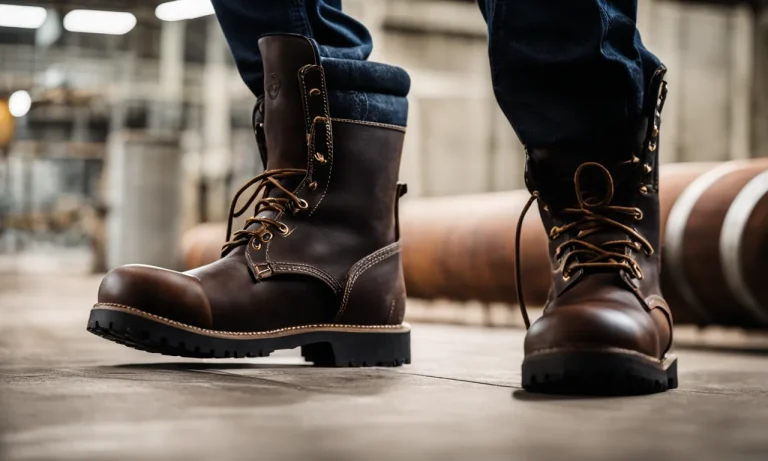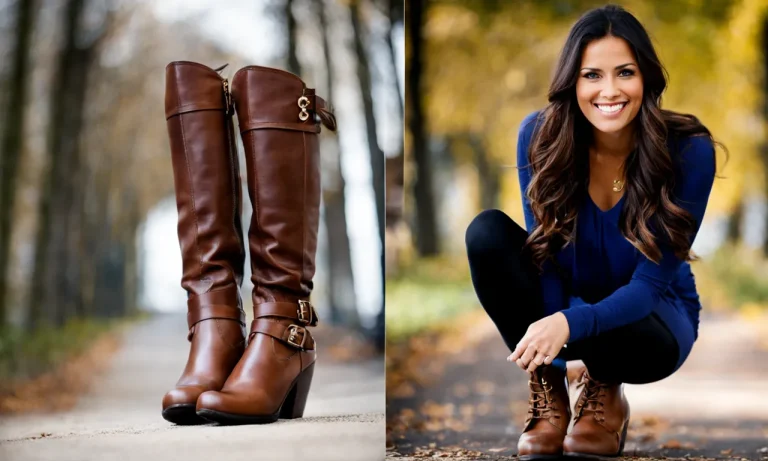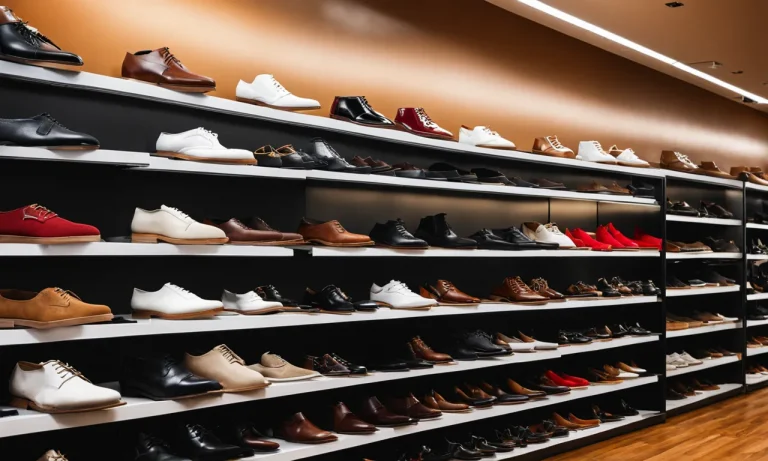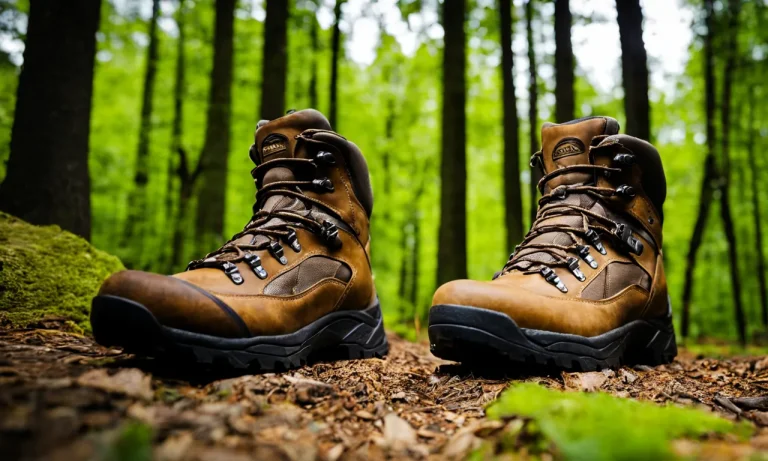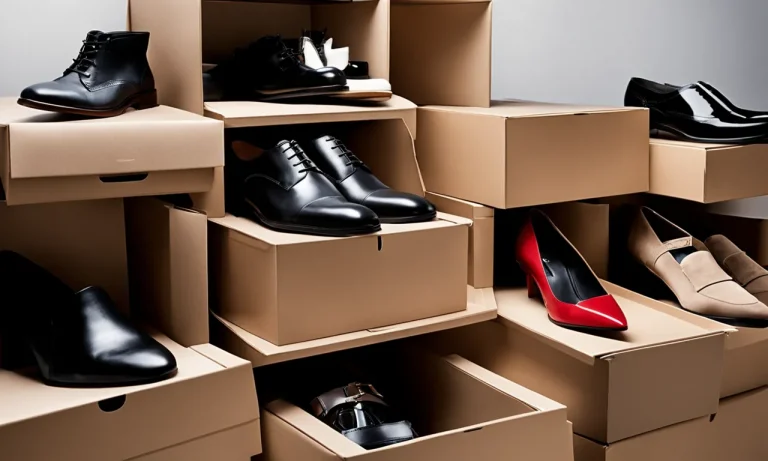Finding the perfect pair of shoes can be tricky if you don’t know your exact size. But with a few simple tools and measurements, you can determine your shoe size from home.
If you’re short on time, here’s a quick answer to your question: Use a brannock device, a ruler, or trace your foot on paper and measure the length and width to determine your size.
In this comprehensive guide, we’ll walk through several methods to measure your foot and convert the measurements to shoe sizes so you can find the perfect fit every time.
Using a Brannock Device
What a Brannock Device Is
If you’re unsure about your shoe size and need an accurate measurement, a Brannock Device is an essential tool. Developed in the early 1920s by Charles F. Brannock, the device is the industry standard for measuring shoe sizes.
It is commonly found in shoe stores and shoe departments, and it provides precise measurements of both length and width.
The Brannock Device consists of a metal base with a sliding ruler and a series of measuring plates. These plates are adjustable to fit various foot sizes and shapes, ensuring an accurate measurement for everyone.
With its simple yet effective design, the Brannock Device has become a staple in the footwear industry and is trusted by professionals and shoe enthusiasts alike.
How to Use a Brannock Device
Using a Brannock Device is straightforward and can be done on your own or with the assistance of a salesperson. Follow these steps to measure your shoe size:
- Step onto the metal base of the Brannock Device with your heel against the back
- Place your foot flat on the device, ensuring that your weight is evenly distributed
- Align your longest toe with the measuring arrow or line on the device
- Slide the measuring plates to touch the widest part of your foot, ensuring a snug but not tight fit
- Read the measurements displayed on the device for both length and width
By following these steps, you can obtain an accurate shoe size measurement using the Brannock Device.
Reading the Measurements
When using a Brannock Device, it’s important to understand how to read the measurements correctly. The device provides measurements in both American and European shoe sizes.
The length measurement is usually displayed on the horizontal scale, while the width measurement is shown on the vertical scale. The length is indicated by a series of numbers, typically ranging from 3 to 16 for adults.
For width, the device uses a series of letters ranging from AAA (narrowest) to EEE (widest). These letters represent the width of the shoe at the ball of the foot.
It’s worth noting that shoe sizing can vary between different brands and styles, so it’s always a good idea to try on shoes before making a purchase. Additionally, if you have specific foot conditions or concerns, it’s best to consult with a podiatrist or footwear specialist for personalized advice.
For more information on the Brannock Device and its history, you can visit the official Brannock Device website.
Tracing Your Foot and Measuring
Materials Needed
To measure your shoe size without knowing the size, you will need a few materials:
- A piece of paper larger than your foot
- A pencil or pen
- A ruler or tape measure
Tracing Method
Start by placing the piece of paper on a flat surface. Sit down and place your foot firmly on the paper. Use the pencil or pen to trace the outline of your foot. Make sure to keep the pen or pencil perpendicular to the paper for accurate measurements.
Trace both the left and right foot separately, as they may have slightly different sizes.
Measuring Length and Width
Once you have traced the outline of your foot, use the ruler or tape measure to measure the length and width of your foot.
Measure the length from the tip of your longest toe to the back of your heel. For the width, measure the widest part of your foot, typically around the ball of your foot.
Converting Measurements to Shoe Sizes
Now that you have the measurements of your foot, you can convert them to shoe sizes. Different brands and countries may have slightly different size charts, so it’s important to refer to the specific size chart of the brand or store you are purchasing from.
Many online shoe retailers provide size charts that correlate foot measurements to shoe sizes. You can also visit a local shoe store and ask a salesperson for assistance in finding the right shoe size based on your measurements.
Remember that it’s common for one foot to be slightly larger than the other, so always measure both feet and use the larger measurement when determining your shoe size.
By using the tracing and measuring method, you can more accurately determine your shoe size without knowing the size beforehand. This can be particularly helpful when shopping online or when your shoe size may have changed over time.
Measuring with a Ruler
When it comes to measuring your shoe size without knowing the size, using a ruler can be a simple and effective method. By following these steps, you can determine both the length and width of your foot, helping you find the right shoe size for a comfortable fit.
Materials Needed
To measure your shoe size with a ruler, you’ll need the following materials:
- A ruler with both inches and centimeters
- A piece of paper or cardboard
- A pen or pencil
Measuring Foot Length
The first step is to measure the length of your foot. Place the piece of paper or cardboard on the floor and stand on it with your heel against a wall. Use the pen or pencil to mark the longest part of your foot, which is usually the tip of your big toe.
Then, use the ruler to measure the distance from the wall to the mark you made. This measurement will be your foot length.
Determining Width
Next, you’ll need to determine the width of your foot. Wrap the ruler around the widest part of your foot, which is usually around the ball of your foot. Take note of the measurement in both inches and centimeters.
Converting Ruler Measurements to Shoe Size
Once you have the measurements of your foot length and width, you can use these measurements to find your shoe size. Different shoe brands and manufacturers may have slightly different sizing charts, so it’s important to consult the specific brand’s sizing guide for the most accurate results.
Many shoe retailers provide online sizing guides that can help you convert your measurements into the appropriate shoe size.
Pro Tip: If you’re unsure about the accuracy of your measurements, it’s always a good idea to try on shoes in-store or order multiple sizes online to ensure the best fit.
Remember, measuring your shoe size with a ruler is a helpful method, but it’s always recommended to consult the brand’s sizing guide for the most accurate results. With the right size, you can step out confidently and comfortably in your new shoes!
Considering Other Factors for Proper Fit
When it comes to measuring your shoe size without knowing the exact size, there are a few other factors you should consider to ensure a proper fit. These factors can greatly affect the comfort and performance of your shoes.
Foot Shape
One important factor to consider is your foot shape. Different shoe brands and styles are designed to accommodate different foot shapes, such as narrow, wide, or high-arched feet. It’s essential to know your foot shape to choose the right shoe size that will provide the best fit and support for your feet.
Sock Thickness
The thickness of your socks can also affect the fit of your shoes. If you usually wear thick socks, you may need to go up a half size or more to accommodate the extra volume. On the other hand, if you prefer thin socks or plan to wear your shoes without socks, you might need to go down a size to prevent your feet from sliding inside the shoes.
Time of Day
Believe it or not, your foot size can slightly change throughout the day. This is due to factors such as swelling from standing or walking for extended periods. To get the most accurate measurement, it’s recommended to measure your feet in the afternoon or evening when they are at their largest size.
This way, you can ensure a comfortable fit even during the times when your feet are slightly swollen.
Foot Conditions
If you have any specific foot conditions, such as bunions, plantar fasciitis, or flat feet, it’s crucial to consider them when measuring your shoe size. Certain conditions may require you to choose shoes with specific features, such as extra-wide widths, arch support, or cushioning.
Consulting with a podiatrist or foot specialist can provide valuable insights into the right shoe size and type for your specific foot condition.
Remember, measuring your shoe size is just the first step in finding the perfect fit. Considering these other factors can make a significant difference in your overall comfort and satisfaction with your footwear.
So, next time you’re shopping for shoes, take these factors into account and ensure you’re getting the best fit for your feet.
Conclusion
Knowing your precise shoe size is important for comfort and preventing foot issues. With some simple DIY methods and tools, you can measure your feet and determine your size without having to go to a shoe store.
Just remember to measure both feet, account for foot shape and sock thickness, and convert the measurements properly. Finding the perfect shoe fit is achievable with these handy tips for measuring your feet.

